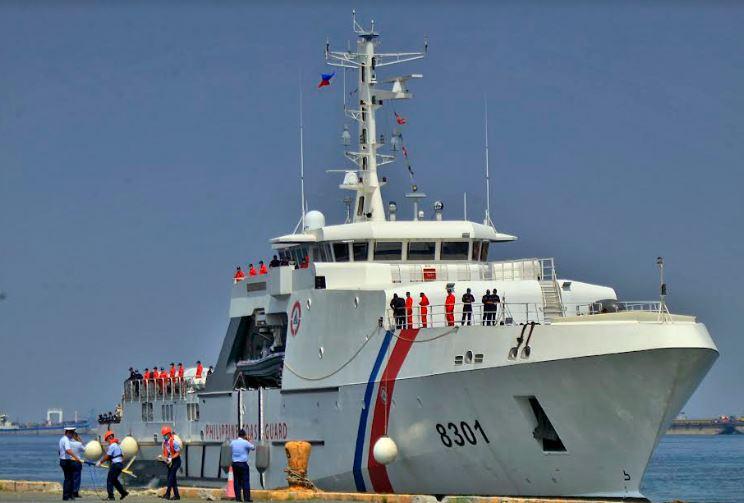TIMELINE: BRP Teresa Magbanua at Sabina Shoal

After spending five months in Sabina or Escoda Shoal, the BRP Teresa Magbanua, the largest ship of the Philippine Coast Guard (PCG), has reportedly left the disputed area in the West Philippine Sea.
Sabina Shoal is located 75 nautical miles or about 140 kilometers off Palawan and lies within the Philippines’ 200-nautical-mile exclusive economic zone (EEZ). China, which claims the shoal as as part of Nansha Qundao, calls it Xianbin Jiao.
Here's an overview of BRP Teresa Magbanua’s five-month long deployment:
April 2024 - The PCG deployed BRP Teresa Magbanua to monitor China's alleged reclamation activities in Sabina Shoal, as crushed corals were found dumped on the seabed of the contested territory.
May 10 - The PCG said the crushed corals were dumped near Sabina Shoal similar to those observed in Sandy Cay.
May 11 - The PCG said that the dumping of crushed corals near Sabina Shoal may be in preparation for China's reclamation activities to build structures on top of the maritime feature, which is much closer to Palawan than the contested Ayungin Shoal in the West Philippine Sea.
June 2 - It was reported that a Chinese Coast Guard vessel and two Chinese maritime militia vessels shadowed the BRP Teresa Magbanua at the Escoda Shoal.
June 7 - The PCG said China's People's Liberation Army Navy (PLAN) conducted exercises during a Filipino team’s marine scientific survey in Escoda Shoal.
The Chinese military also reportedly launched a hovercraft and aircraft and performed maneuvers at sea.
Scientists from the University of the Philippines (UP) also revealed that the corals in Sabina Shoal are now "almost 100% dead.”
July 3 - China Coast Guard (CCG) ship CCG 5901, the world's largest coast guard ship known as "The Monster”, proceeded to Escoda Shoal and kept watch over BRP Teresa Magbanua.
July 5 - The PCG said that "The Monster" was deployed to the Escoda Shoal to intimidate the BRP Teresa Magbanua.
August 17 - The Chinese Foreign Ministry said it lodged a formal protest over the presence of BRP Teresa Magbanua at Escoda Shoal, saying that it “seriously infringes on China’s sovereignty, violates the Declaration on the Conduct of Parties in the South China Sea, and threatens the peace and stability in the South China Sea.”
August 18 - The PCG stood firm the Escoda Shoal is located within the Philippines’ EEZ based on international law and has the right to operate there despite China’s claims to the contrary.
August 25 - CCG vessels rammed and used a water cannon on the BRP Datu Sanday of the Bureau of Fisheries and Aquatic Resources (BFAR) near Escoda Shoal.
August 27 - The PCG said the essential supplies and food requirement to feed the Filipino crew on BRP Teresa Magbanua were at a critical level after Chinese vessels blocked the resupply missions.
August 31 - CCG vessel 5205 approached BRP Teresa Magbanua and "carried out a dangerous maneuver resulting in its direct ramming on the port bow” of BRP Teresa Magbanua, according to PCG.
The PCG said the repeated ramming of the vessel was "intentional" and "happened despite [their] unprovoked action and presence in Escoda Shoal."
September 11 - Philippine Foreign Affairs Undersecretary Theresa Lazaro and her counterpart Chinese Vice Foreign Minister Chen Xiaodong had a "frank and in-depth" exchange on sea-related issues, particularly regarding the Sabina Shoal.
September 12 - The DFA announced that the Philippines and China maintained their respective positions on a disputed shoal in the South China Sea, but vowed to explore ways to prevent confrontations. No breakthrough was reached on how to resolve an ongoing conflict in Sabina Shoal.
September 14 - The United States Naval Institute News reported the BRP Teresa Magbanua was tracked by AIS data posted on social media leaving Sabina Shoal then sailing in the Sulu Sea.
Escoda Shoal is a coral reef formation with a central lagoon surrounded by discontinuous shallow sections.
It is a rendezvous point for Philippine vessels headed to Ayungin Shoal, another contested feature in the West Philippine Sea, where the World War II-era vessel BRP Sierra Madre was deliberately grounded in 1999 to maintain the Philippines’ territorial claim and to serve as a lookout post in the disputed waters.
—RF, GMA Integrated News




